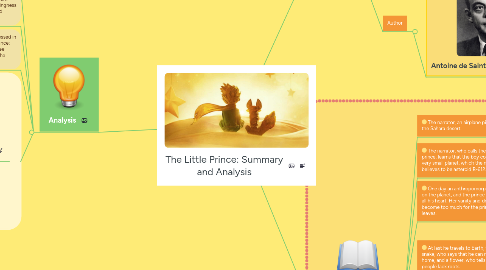
1. Analysis
1.1. The Little Prince draws unflattering portraits of grown-ups as being hopelessly narrow-minded.
1.2. In contrast, children come to wisdom through open-mindedness and a willingness to explore the world around them and within themselves.
1.3. The main theme of the fable is expressed in the secret that the fox tells the little prince: “It is only with the heart that one can see rightly: what is essential is invisible to the eye.”
1.4. The End
1.4.1. The story of the little prince ends in mystery. We are left to figure out whether the prince has managed to save his rose.
1.4.2. The only thing that is certain is that one of the prince’s first questions, about whether the sheep will eat his rose, has emerged in the end as the most important question of all.
1.4.3. The final chapters are an allegory about dealing with the death of a loved one.
1.4.4. The Little Prince deals with serious and even upsetting issues, though emphasizes the idea that good can be derived from sad events.
2. About This Book
2.1. The Little Prince is philosophical tale, with humanist values, shared from one generation to another for more than 75 years.
2.1.1. The novella has been translated into hundreds of languages and has sold some 200 million copies worldwide, making it one of the best-selling books in publishing history.
2.2. The Little Prince fable and modern classic that was published with his own illustrations in French as Le Petit Prince in 1943.
2.2.1. The simple tale tells the story of a child, the little prince, who travels the universe gaining wisdom.
2.3. Author
2.3.1. Antoine de Saint-Exupéry
2.3.1.1. Born on July 29th in Lyon, in an old Aristocratic Family, Antoine de Saint-Exupéry serves in the Air army and becomes a pilot.
2.3.1.2. He received his pilot’s wings during his compulsory military service in 1922, around which time he also began to write.
2.3.1.3. His vocation feed his writing, and both give him the French Medal of Honor.
2.3.1.4. His adventures as a pilot would supply the inspiration for all of his literary endeavors, which culminated with the 1943 publication of the classic The Little Prince.
2.3.1.5. He disappeared in July 1944 while flying a reconnaissance mission over occupied France during World War II, leading to speculation over the cause of his death that persists to the present day.
3. Plot Overview
3.1. The narrator, an airplane pilot, crashes in the Sahara desert.
3.1.1. He encounters a small boy who asks him for a drawing of a sheep, and the narrator obliges.
3.2. The narrator, who calls the child the little prince, learns that the boy comes from a very small planet, which the narrator believes to be asteroid B-612.
3.2.1. On his asteroid-planet, which is no bigger than a house, the prince spends his time pulling up baobab seedlings.
3.3. One day an anthropomorphic rose grows on the planet, and the prince loves her with all his heart. Her vanity and demands become too much for the prince, and he leaves.
3.3.1. The prince travels to a series of asteroids, each featuring a grown-up who has been reduced to a function.
3.4. At last he travels to Earth, where he meets a snake, who says that he can return him to his home, and a flower, who tells him that people lack roots.
3.4.1. He comes across a rose garden, and he finds it very depressing to learn that his beloved rose is not, as she claimed, unique in the universe.
3.4.2. A fox then tells him that if he tames the fox then they will be unique and a source of joy to each other.
3.5. The narrator and little prince have now spent eight days in the desert and have run out of water.
3.5.1. The two then traverse the desert in search of a well, which, miraculously, they find.
3.6. The little prince tells the narrator that he plans to return to his planet and flower and that now the stars will be meaningful to the narrator, because he will know that his friend is living on one of them.
3.6.1. Returning to his planet requires allowing the poisonous snake to bite him.
3.7. The story resumes six years later. The narrator says that the prince’s body was missing in the morning, so he knows that he returned to his planet, and he wonders whether the sheep that he drew him ate his flower.
3.7.1. He ends by imploring the reader to contact him if they ever spot the little prince.
